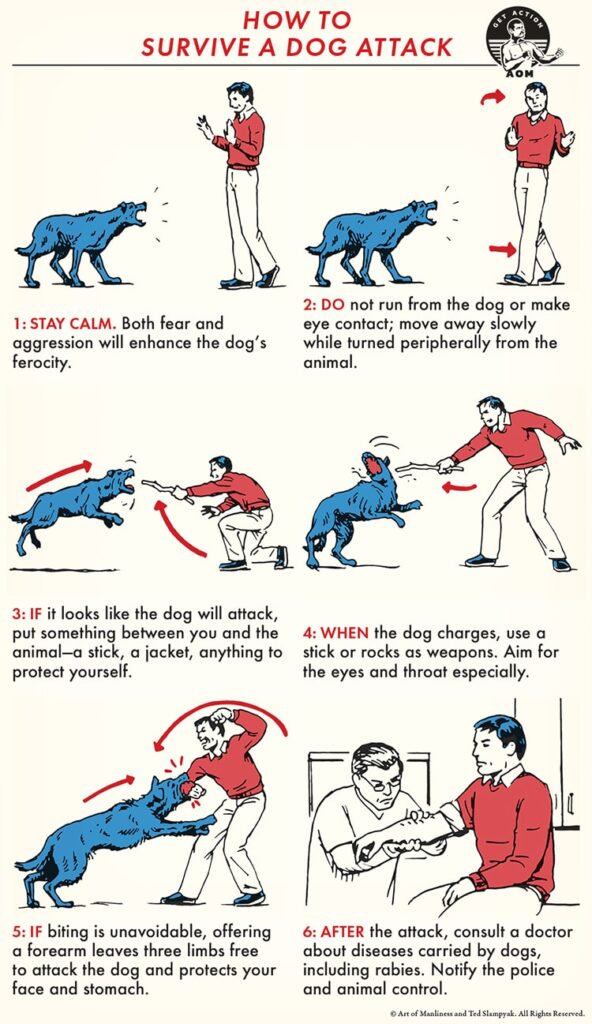An important part of preparedness is having the competence to handle any danger life throws at you—even an unexpected canine ambush. Urban explorers, hikers, mail carriers, and anyone spending time outdoors may, at some point, confront a hostile dog. While most stray or off‑leash dogs simply bark and bluff, a small percentage can become dangerously aggressive. Learning a structured, multi‑step response can mean the difference between walking away shaken—and walking away unscathed.
1. Prevention: Read the Warning Signs
Before any threat escalates, you can often defuse the situation by recognizing key canine body language:
- Stiff posture and raised hackles: The fur along the dog’s neck and back standing up indicates arousal or aggression.
- Direct, hard stare: Dogs that lock eyes are signaling dominance or a challenge.
- Lip curl, teeth baring, snarling: Clear signs it’s ready to bite if provoked.
- Ears pinned back, tail held high or tucked tightly: Both can signal fear‑aggression or anxiety.
What to do: Slow your breathing, unclench your fists, and freeze. Avoid eye contact—look at the dog’s shoulders or feet. Stand sideways to present a less confrontational profile.
2. De‑Escalation: Stay Calm and Command Respect
Dogs are masters of emotional contagion: they feed off your adrenaline and anxiety. Your best tools are a steady voice and confident posture:
- Speak in a low, firm tone: “No,” “Go home,” or “Stay” in a calm baritone can mimic basic obedience commands.
- Maintain relaxed body language: Keep your arms by your sides (no waving or flailing); stand tall with weight on your back foot.
- Back away slowly: Never turn your back or run; sudden movement triggers the chase instinct.
Most dogs will bark and circle when they realize you’re not an easy target. Giving a calm, assertive cue often convinces them to disengage.
3. Deterrence: Use Distractions and Barriers
If initial de‑escalation fails and the dog advances, introduce nonviolent warnings before resorting to physical defense:
- Simulate throwing an object: Reach toward a rock or stick, cock your arm as if to throw—this often spooks the dog, buying you time.
- Put an object between you: Hold a backpack, jacket, or purse in front of you. A raised barrier can shield sensitive areas.
- Use auditory deterrents: A short, loud whistle or shout can startle some dogs, interrupting their charge.
If you do throw—aim not to injure the dog, but to land near it. A near‑miss on the ground often breaks its momentum without provoking fatal panic.
4. Defense: Protect Yourself if a Lunge Occurs
When a dog ignores warnings and attacks, you must act decisively to protect vulnerable areas (face, neck, and torso):
- Shield with an object: Hold your bag, backpack, or a rolled jacket against the dog’s teeth, giving you a buffer.
- Anchor your stance: Spread your feet shoulder‑width, keep knees slightly bent, and lean away—this lowers your center of gravity.
- Strike pressure points: Target the dog’s snout with firm, safe strikes—palm heel thrusts upward under its jaw can force it to release.
- Use controlled kicks: If the dog persists, drive your knees and feet into its shoulder or chest—aim low, not at its head, to avoid maiming it.
Always follow up each defensive action by creating distance—step back and resume a de‑escalation posture as soon as the dog retreats.
5. Escape & Recovery: Get to Safety and Treat Wounds
Once you break free, don’t assume the threat is over until you’re out of the dog’s territory:
- Put a solid barrier between you and the animal: Enter a car, home, or climb onto a sturdy platform.
- Call for help: Dial emergency services if the attack leaves serious injuries or if the dog hasn’t yet run off.
- Self‑examine for wounds: Even small punctures risk infection. Wash thoroughly with soap and water, apply antiseptic, and cover with a clean bandage.
- Seek medical attention: Dog bites can transmit bacteria (including rabies risk). A healthcare provider can assess the need for antibiotics, a tetanus shot, or rabies prophylaxis.
6. Reflect & Learn: Improve Your Readiness
After the incident, take stock:
- What early warning signs did you miss? Commit them to memory for next time.
- Which tactics worked best? Reinforce those in future training.
- Could you practice nonviolent deterrence more often? Simulate scenarios (without a dog) to build confidence in barrier use and calm command voice.
By methodically honing these skills—awareness, calmed authority, deterrence, strategic defense, and post‑attack care—you’ll be prepared to survive the rare but real threat of a dog attack. The next time you encounter an aggressive canine, you’ll have the presence of mind and practical toolbox to walk away with your safety—and dignity—intact.






